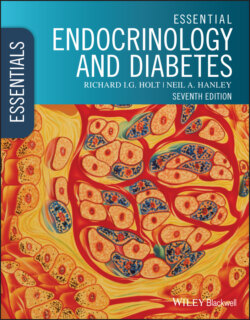Читать книгу Essential Endocrinology and Diabetes - Richard I. G. Holt - Страница 75
Target cell conversion of hormones destined for nuclear receptors
ОглавлениеIn many instances, the ligand for the nuclear receptor undergoes enzymatic modification within the target cell. This converts the circulating hormone into a more or less potent metabolite prior to receptor binding (Table 3.2). For instance, cortisol is metabolized to cortisone by type 2 11β‐hydroxysteroid dehydrogenase (HSD11B2). In kidney tubular cells, this inactivation preserves aldosterone action at the mineralocorticoid receptor (MR). Without this, cortisol, present in the circulation at much higher concentrations than aldosterone, might saturate the MR, causing inappropriate overactivity. Impaired function of HSD11B2 causes the syndrome of ‘apparent mineralocorticoid excess’ characterised by hypertension and hypokalaemia.
Figure 3.14 McCune–Albright syndrome. At 6 years of age, this girl presented with breast development and vaginal bleeding in the absence of gonadotrophins. An activating mutation in Gsα had created independence from melanocyte‐stimulating hormone (MSH) causing skin pigmentation (‘café‐au‐lait’ spots). The same mutation in the ovary had caused constitutive activation leading to premature breast development. In some cases, constitutive over‐activity can cause fibrosis dysplasia in the bones, cortisol excess in the adrenal cortex (Cushing syndrome) and thyrotoxicosis.
From Brook’s Clinical Pediatric Endocrinology, Sixth Edition, Charles G. D. Brook, Peter E. Clayton, Rosalind S. Brown, Eds. Blackwell Publishing Limited. 2009.
Figure 3.15 The activation of protein kinase A, a cAMP‐dependent protein kinase. The four‐subunit complex is inactive. When cAMP binds to the regulatory subunits (red), dissociation occurs so that the active kinase subunits (blue) are released to catalyze the phosphorylation of the cAMP response element‐binding protein (CREB). This activates CREB () so that it can bind to its DNA target, the cAMP response element (CRE), to switch on transcription of cAMP‐inducible genes. RNA POL, RNA polymerase.
